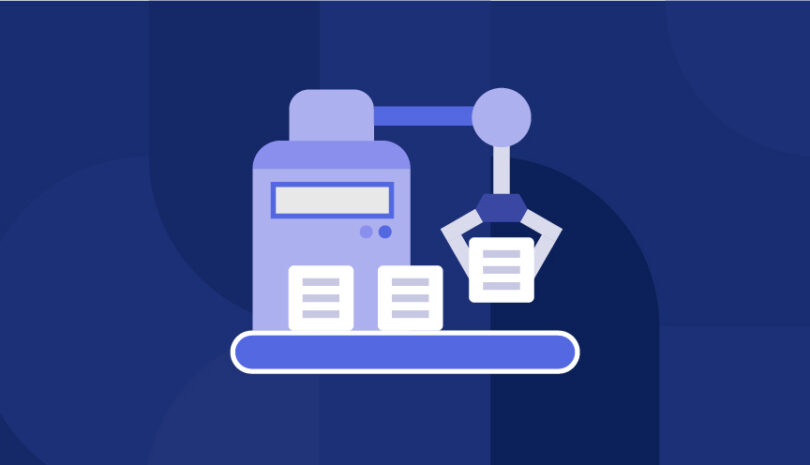If you feel like Internet of Things (IoT) devices are everywhere you look, you’re not wrong. IoT is in your Alexa speaker, in your air-conditioning units, and in your robot-vacuum cleaners. What’s more, it’s also in your supply chains.
In many ways, embracing IoT is a sensible response to today’s highly complex supply chains. They are still riven with flaws, and frequently overextended and undiversified. Disruptions due to war, political instability, extreme weather incidents, and natural disasters have only become more frequent. Meanwhile, customers expect fast delivery times, and trends fluctuate rapidly, forcing companies to place smaller, more frequent orders.
IoT offers a way to overcome these obstacles. With the help of IoT devices, organizations can manage inventory more easily, track the location of their shipments, and monitor the state of their goods. However, IoT devices are often poorly secured and vulnerable to attacks. As IoT proliferates in your supply chain, it opens up more potential entry points for malicious actors.
In this article, we’ll discuss the risks and threats that IoT poses to your organization, and explore best practices for managing IoT cybersecurity and mitigating IoT risk in the supply chain.
The Role of IoT in Supply Chains
IoT devices are transforming supply chains at an impressive speed. Logistics companies, manufacturers, transportation companies, and more are embracing IoT for fleet management, route optimization, regulatory compliance, automation, and predictive maintenance use cases,
as well as providing their clients with visibility into storage and transportation conditions.
For example, logistics companies can use GPS-enabled trackers to follow the real-time location of your shipments, helping ensure timely deliveries, keeping customers updated about transportation times, and reducing the risk of lost or stolen goods. Manufacturers gather data from IoT sensors in their equipment to predict failures and optimize maintenance scheduling, helping prevent unexpected downtime and maximize productivity. IoT-powered inventory management enables real-time data about stock levels and automated reordering to reduce overordering and surprise stockouts.
You can also improve your supply chain management with IoT. Devices like sensors, RFID tags, GPS trackers, and smart meters can continuously monitor your supply chain and collect data, producing real-time insights that support better decision-making. The technology promotes seamless communication and coordination among different stakeholders, helping remove friction. With IoT data, you can maintain supply chain visibility, improve efficiency, and reduce costs throughout the supply chain.
Cybersecurity Risks Posed by IoT in Supply Chains
Unfortunately, IoT devices bring drawbacks as well as benefits. They’re easy and inexpensive to distribute throughout your supply chain, which gives you greater visibility but also significantly extends your attack surface. Every small IoT device is interconnected, serving as a gateway for hackers to infiltrate your broader networks. It’s difficult to secure every node in the vast web of IoT devices, spread between numerous different suppliers and partners.
It doesn’t help that IoT cybersecurity is generally poor. Many devices have outdated software and weak configurations, and stakeholders often forget to change easy-to-exploit default passwords to something more secure. IoT devices frequently lack robust encryption protocols and go overlooked when security patches are released, which increases their vulnerability to cyber-attacks and hacking attempts.
Remember, you’re not the only one using IoT. Your third-party suppliers, vendors, and logistics partners use these devices too. All that malicious actors need is a vulnerability in one third-party IoT device. Then they can (and do) intercept sensitive data and disrupt supply chain operations. Cybercriminals take advantage of poor IoT cybersecurity to gain unauthorized access to your systems and networks, which can halt production lines, delay deliveries, and/or cause substantial financial losses.
The Importance of Third-Party Risk Management in IoT Networks
As IoT devices proliferate across your supply chain, third-party risk management (TPRM) is becoming crucial for preventing and mitigating the threats that they pose. Your third parties and vendors frequently have access to your sensitive data and critical systems. If hackers succeed in exploiting their IoT vulnerabilities and entering their IoT devices, they can often move laterally through their systems to yours.
This opens up tremendous and damaging possibilities for supply chain disruptions. A breach in a single third-party IoT device can cascade through the supply chain, causing operational delays, data breaches, and financial losses. Unless you implement robust TPRM practices, you won’t know which IoT devices are used by your third parties, how often they patch and update them, or anything about their approach to changing passwords.
For example, if an IoT sensor in a third-party logistics provider’s system is compromised, it could feed incorrect data into inventory management systems, resulting in unexpected shortages or overstocking. Hacked GPS trackers could redirect your shipments to another location. More seriously, the IoT thermostat on manufacturing equipment could be hacked so that the temperature rises to dangerous levels without anyone knowing.
Common Threats in IoT-Enabled Supply Chains
As mentioned already, IoT devices possess many weaknesses, making them tempting targets for malicious actors. Without strong IoT cybersecurity, your trackers, sensors, RFID tags, and other devices can turn into serious security threats.
There are numerous ways that hackers can gain unauthorized access to IoT devices and/or turn them into weapons for further attacks. These include:
- Botnet attacks that leverage IoT devices
- Insider threats and compromised endpoints
- Weak authentication in third-party IoT systems
Let’s take a closer look at each of these IoT supply chain threats.
Botnet Attacks Leveraging IoT Devices
Poor IoT cybersecurity means that IoT devices can be compromised to serve as bots for malicious actors. Attackers target devices like smart cameras, thermostats, and routers, which routinely have weak security configurations, default passwords that are easy to guess, and outdated software with zero-day vulnerabilities.
Once compromised, attackers use these devices as part of a botnet to attack larger networks and systems. They leverage botnets to carry out nefarious activities like distributed denial-of-service (DDoS) attacks, overwhelm websites with traffic, send spam, steal data, and facilitate other cybercrimes.
Insider Threats and Compromised IoT Endpoints
Like many other areas of IT security, human action can severely affect IoT cybersecurity. Employees, contractors, or partners with your organization might deliberately abuse their legitimate access to IoT endpoints, using them to steal data, sabotage the systems, and/or disrupt operations.
IoT cybersecurity is also easily affected by human error. Insiders who neglect security protocols, use weak passwords, or fail to run software patches can inadvertently compromise your IoT endpoints. Compromised IoT endpoints have already been infiltrated or tampered with, enabling malicious actors to enter your critical systems or turn the devices into tools for further cyberattacks.
Exploiting Weak Authentication in Third-Party IoT Systems
Cybercriminals are quick to take advantage of weak authentication mechanisms used to authorize access to IT systems. These include easy-to-guess passwords and/or failing to implement multi-factor authentication (MFA), which serves as an extra layer of protection against unauthorized access.
IoT devices typically come with default credentials, and users don’t always change them. Even when people replace default passwords, they might use simple passwords that can be cracked by guesswork or a brute force attack. Once an attacker gains access credentials, they can control the IoT device, access sensitive data, or use it as a launching point for further attacks.
Best Practices for Managing IoT-Related Third-Party Risks
The good news is that there are concrete, actionable steps that you can take to minimize the IoT-related risks posed by your third parties. Every organization should adopt IoT cybersecurity best practices to prevent attacks via third-party IoT devices.
These include:
- Rigorously assessing your third parties’ IoT cybersecurity practices
- Mandating regular updates and security patches for all supply chain IoT
- Establishing real-time monitoring for IoT traffic and IoT device behavior
- Requiring secure authentication protocols and data encryption for all third-party IoT
Let’s take a closer look at these best practices.
Implementing Robust Third Party Security Assessments for IoT Vendors
Strong IoT cybersecurity begins by knowing what you’re dealing with. Your vendor risk assessment process needs to include a thorough examination of each third party’s IoT cybersecurity measures, to check that they meet your standards and relevant compliance and security frameworks.
This assessment should include specific questions on your security questionnaires, a careful review of their IoT security documentation, and a close look at the specific technologies they use. You might want to run an on-site audit to check who has physical access to IoT devices. Evaluate everything against the sensitivity and criticality of their services to your business continuity.
Regularly Updating and Patching IoT Devices Across Supply Chains
As we’ve discussed, outdated software and unpatched vulnerabilities are a critical risk factor in IoT cybersecurity. To mitigate this, you’ll need an accurate inventory of all IoT devices, including details about the manufacturer, model, firmware version, and patch status. Then you can set a schedule for updates to all the devices in your supply chain so that nothing hides under the radar.
Automated tools for vulnerability management can streamline the identification of outdated firmware and missing patches. It’s best to include clauses in your contracts that require vendors to keep their devices updated and patched, and promptly inform you about security vulnerabilities.
Real-time Monitoring of IoT Traffic and Device Behavior
At the same time, keep a careful eye on your IoT supply chain. You want to know about security threats before they escalate so that you can act to mitigate them. Unusual communication between IoT devices is typically an early sign of cyber attacks.
Automated monitoring solutions can track network traffic to and from IoT devices, using machine learning (ML) to understand normal behavior patterns and detect deviations that could indicate security threats. It’s best to integrate monitoring tools with a centralized SIEM system that can correlate data against information from other sources, enabling faster and more accurate threat detection and response.
Secure Authentication Protocols and Data Encryption for Third-Party IoT Systems
Finally, you’ll want to protect sensitive information and data integrity by implementing secure authentication protocols and data encryption for third-party IoT systems. This should involve enforcing a combination of strong passwords, MFA, biometric verification, and one-time tokens so that only authorized individuals and systems can access the IoT network.
Data encryption is equally vital. Make sure that all your third parties apply robust encryption standards for information both in transit and at rest, with secure encryption key management for key generation, distribution, and storage. Regularly updating and rotating encryption keys further enhances IoT cybersecurity.
Enhancing IoT Security Through Collaboration with Third Parties
The only way to succeed in implementing strong IoT cybersecurity is through ongoing collaboration with your third parties. You need their cooperation in the fight against cyber attacks, so set up communication channels and encourage them to keep you updated about security threats, incidents, and emerging risks.
Conduct joint incident response planning so that everyone is on the same page about how to handle IoT attacks, and clearly communicate your expectations, especially around software updates, patches, access controls, and data privacy. Write SLAs and other security standards into your contracts so that there’s an enforcement mechanism, and encourage continuous vendor training and awareness around IoT cybersecurity.
IoT Cybersecurity Solutions for Supply Chains
Given the serious risks opened up by IoT devices and their preponderance in supply chains, IoT cybersecurity should be a priority for every organization. Without a proactive third-party risk management strategy, you’re effectively leaving open a myriad of potential entry points to your business-critical systems and sensitive data.
Third-party IoT devices need to be kept patched and updated, protected from unauthorized access, monitored and managed using cybersecurity best practices. Panorays is here to help with this monumental task. The platform maps your supply chain, ensuring that you know about all the IoT devices that could be hiding within it, and prioritizes those that pose the highest risk so that you can focus your mitigation resources more effectively.
The solution offers automated third-party security questionnaires which streamline the process of assessing and evaluating your vendors’ IoT cybersecurity practices, and provide a dynamic Risk DNA score that helps you keep track of emerging risks in your IoT supply chain. Additionally, automated monitoring tools deliver continuous visibility into third-party IoT traffic and behavior for early warnings about IoT threats.
Ready to close up vulnerabilities and manage IoT devices in your supply chain? Contact Panorays to learn more.
IoT Cybersecurity FAQs
-
IoT stands for Internet of Things. It’s a network of interconnected devices that communicate and exchange data with each other over the internet. These devices can be found in a range of items, from household appliances to industrial machinery and medical equipment. They enable automated systems that gather, share, and act on data in real-time.
-
The most common IoT cyber attacks include:
- Ransomware, which encrypts the data on the IoT device
- Man-in-the-middle (MitM) attacks which intercept and alter communications between IoT devices
- Botnet attacks using numerous hijacked IoT devices to launch further attacks
- DDoS attacks, use a network of compromised IoT devices to crash a target system
-
IoT in cybersecurity means security measures and strategies used to protect IoT devices and the networks on which they operate. IoT cybersecurity aims to safeguard these devices from malicious attacks, using a range of practices including strong authentication, robust data encryption, regular updates and patches, and ongoing monitoring.



